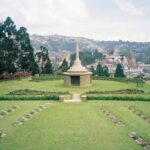Tying the Knot? Seek Blessings at Kalyan Swami Temple
Sri Kalyana Venkateswara Swamy Alyam is is an ancient Hindu temple at Srinivasamangapuram in Tirupat. In Telugu, “Alyam” means home. It is believed that after his marriage to Padmavati, Lord Venketeswara Swamy spent six months living here.
The actual year and century of the temple have not yet been determined by archaeologists and temple experts. During the Sultans’ rule in 1324, the historic Sri Kalyana Venkateswara Swamy temple was destroyed. Later, Chinna Tirumala Acharya, the poet-sage Annamacharya’s grandson, restored it in the 16th century. After that, the Tallapaka family looked after it for a while. The temple was governed by the Archaeological Survey of India (ASI) from 1967 to 1981 before being turned over to Tirumala Tirupati Devasthanam. The ASI has categorised the temple as an ancient monument of national importance.

Night view of the Sri Kalyan Swami Temple, Mangapuram https://www.trawell.in/andhra/tirupati/srinivasa-mangapuram
Architecture/ Materials Used/ Detailing/ Orientation/ Craftsmanship
The temple was constructed in traditional Vijayanagara fashion. The main gateway, known as Mahadwarsm, is perched atop the “Adhishtanam,” a stone that is 10 feet tall. On either side of the entrance are stone statues of Tallapaka Annamacharya and his son Pedda Tirumala Acharya. A Dhwaja Sthambha with a pataka on top, symbols of Vaishnava traditions, and Garuda Dhwaja platforms can be found inside the temple complex. The temple’s door jambs have mala vahakas, elaborate flora with makara torana, lady attendants and a Gaja Lakshmi motif, as well as wall sculptures of elephants and horsemen.
Three shrines are part of the Venkateswara Vishnu Temple complex in Mangapuram. The two-life-size statue of Venkateswara Vishnu is located in the temple’s central shrine. He is known as Kalayana Venkateswara Swamy and is the temple’s presiding deity. The four-armed god is standing and facing west. Along with the seated statue of Lakshmi Narayana, there is an idol of Sri Ranganatha Swamy in a side chamber of the temple compound. Vishvakshamapathi’s idol is located in the third chamber or on the opposite side of the side room. Themandapa, which dates to the 14th through the 16th centuries AD, was allegedly erected during a later stage of the temple’s construction, according to the Archaeological Survey of India.

Main building of the temple complex
https://www.tirupatihelps.com/srinivasa-mangapuram-temple-history-timings/
On a raised platform or plinth with ornate sculptures and mouldings on upana, adhisthana, and superimposed by a vedika frieze are the sanctum sanctorum and the side chambers, including the mandapam. 36 intricately carved pillars in the Mukha mandapa give it a lovely appearance. According to specialists in temple architecture, the mandap, also known as the temple porch or platform, was constructed between the 14th and 16th centuries and is considered to be the temple complex’s slightly later addition. There are exquisitely carved stone figurines that resemble Vijayanagar architecture.
The mandapams outside the temple date from the 14th to the 16th century. Both the Aartha Mandapa and the Maha Mandapa are square structures with pillars and pilasters. The toranas of the gaja (elephant), simha (lion), and makara (crocodile), as well as pushpa potikas, lotus buds, and friezes, are all included in these.
Sociological Aspect
For newlywed couples, who make this their first stop for prayers soon after their wedding, the temple has special meaning. It is also stated that people who are having problems getting married can pray here and resolve their issues. Every day from 11 am to 12 pm, the Lord is worshipped here during Kalyanotsavam. Attending this rite is thought to help devotees find relief from their problems.

Deity - Venkateshwara Vishnu
https://www.thetelugus.com/blog/2019/12/07/sri-kalyana-venkateswara-swamy-alayam-srinivasa-mangapuram/?amp=1
Folklore/Oral traditions
According to legend, Lord Venkateswara left for Tirumala after marrying Padmavathi, the daughter of King Akasa Raja. However, while travelling, Venkateswara visited Sage Agastya who blessed the newlyweds before informing them of a proverb that states newlyweds shouldn’t climb any hills for the first six months of their marriage. Venkateswara and Padmavati spent the following six months residing at the ashram.
Lord Venkateswara and Padmavati were prepared to return to Tirumala after the six-month period was over. Venkateswara did, however, make two commitments before departing the ashram. One was a temple at the foot of the hill for those who, due to a disability, would not be able to climb the hill and get His darshan at Tirumala. The second was for individuals preparing to enter grihasthashram, or be hitched. Venkateswara guaranteed that individuals who attended the Tirumala Kalyanotsavam would always find a suitable partner.

Embellished pillars of the Temple
https://www.thetelugus.com/blog/2019/12/07/sri-kalyana-venkateswara-swamy-alayam-srinivasa-mangapuram/?amp=1
Maintenance and Upkeep
Since 1967, Tirumala Tirupati Devasthanams have been maintaining this historic temple, which is under the supervision of the Archaeological Survey of India (ASI), and rituals and utsavams have been conducted there since 1981.
Bibliography:
- Government of Andhra Pradesh. Mining Report of Chittoor District. Accessed March 27, 2025. https://www.mines.ap.gov.in/miningportal/downloads/applications/chittoor.pdf
- Tirumala Tirupati Devasthanams. More Temples. Accessed March 27, 2025. https://www.tirumala.org/MoreTemples.aspx.
- in. Srinivasa Mangapuram. Accessed March 27, 2025. https://www.trawell.in/andhra/tirupati/srinivasa-mangapuram.
- Tirupati Helps. Srinivasa Mangapuram Temple History & Timings. Accessed March 27, 2025. https://www.tirupatihelps.com/srinivasa-mangapuram-temple-history-timings/.
- Srinivasa Mangapuram: Importance, History, Legend & Story. Accessed March 27, 2025. https://prayanamam.com/srinivasa-mangapuram-importance-history-legend-story/.
- The Telugus. Sri Kalyana Venkateswara Swamy Alayam, Srinivasa Mangapuram. December 7, 2019. Accessed March 27, 2025. https://www.thetelugus.com/blog/2019/12/07/sri-kalyana-venkateswara-swamy-alayam-srinivasa-mangapuram/?amp=1.
- The Hindu. “He Weaves Stories Around Tirumala-Tirupati Landmarks.” June 18, 2016. Accessed March 27, 2025. https://www.thehindu.com/news/national/andhra-pradesh/He-weaves-stories-around-Tirumala-Tirupati-landmarks/article14427629.ece.
- The Hans India. “Tirupati: ASI Official Inspects Kalyana Venkateswara Temple.” October 22, 2021. Accessed March 27, 2025. https://www.thehansindia.com/news/cities/tirupathi/tirupati-asi-official-inspects-kalyana-venkateswara-temple-714567.
About the Author:
Author: Sadia Shakil
Sadia Shakil is a post graduate in History and an independent researcher with specialisation in the field of art and cultural history. Her work spans heritage sites, historical literature and art and craft blogs.



